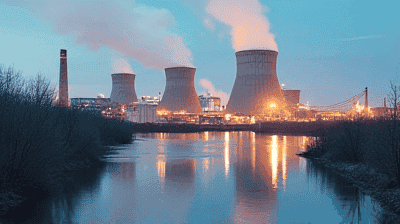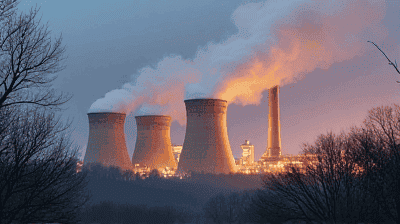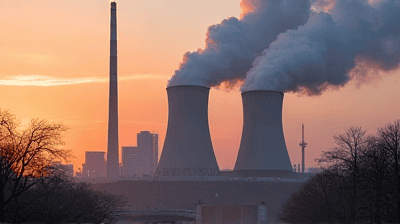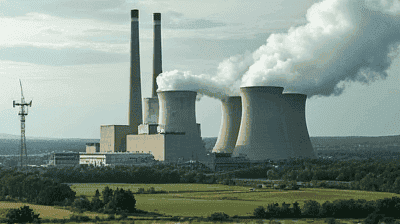
As the demand for energy continues to rise globally, power plants remain a primary source of electricity generation. However, many power plants, especially those that are thermoelectric, contribute significantly to thermal pollution—an often-overlooked environmental issue. Thermal pollution refers to the alteration of water temperatures in natural water bodies caused by human activities, particularly in power generation and industrial processes.
Thermal pollution occurs when an industrial facility, such as a power plant, discharges heated water into a natural water body, leading to an increase in the temperature of that body of water. This increase in temperature can disrupt the natural balance of aquatic ecosystems, affecting the flora and fauna that depend on specific thermal conditions.
The primary sources of thermal pollution are:
Cooling Water Discharges: Power plants typically use large quantities of water to cool their systems. The water absorbs heat during the cooling process and is subsequently returned to the source water body at a higher temperature.
Industrial Processes: Industries such as manufacturing and chemical processing often use water for cooling and may discharge heated water into nearby rivers, lakes, or oceans.
Deforestation and Land Use Changes: Land use changes that involve removing vegetation can reduce shade in waterways, leading to increased water temperature from solar radiation.
Urban Runoff: Heat-absorbing impervious surfaces in urban environments can lead to higher runoff temperatures, which may eventually enter nearby water bodies.

Power plants generate electricity through various methods, including fossil fuels, nuclear, and renewable sources. The energy production methods have differing impacts on thermal pollution:
Fossil Fuel Power Plants: These plants rely on the combustion of coal, oil, or natural gas to produce heat and electricity. Cooling systems often discharge large volumes of heated water back into natural water bodies.
Nuclear Power Plants: Nuclear reactors use water as a coolant, and similar to fossil fuel plants, the heated water is released into nearby aquatic environments, raising their temperatures.
Geothermal Power Plants: While geothermal plants utilize heat from the Earth, if not managed properly, the discharges can lead to thermal pollution, particularly in areas where geothermal fluids are mixed with surface water.
Many older power plants use once-through cooling systems that withdraw water from a nearby source, use it to cool equipment, and discharge it back at elevated temperatures. These systems are less efficient and contribute to greater thermal pollution compared to modern cooling technologies.
Increasing ambient temperatures due to climate change can exacerbate thermal pollution. As global temperatures rise, water bodies may already be warmer, leading to amplified effects when heated water is discharged.
The consequences of thermal pollution can be profound, affecting aquatic ecosystems, water quality, and human health.
Thermal pollution impacts ecosystems in several ways:
Altered Species Composition: Many aquatic organisms have specific thermal tolerances. An increase in temperature can favor heat-loving species (thermophiles) over others, leading to changes in species composition and reducing biodiversity.
Oxygen Levels: Warmer water holds less dissolved oxygen. Lower oxygen levels can lead to hypoxia, a condition harmful to fish and other aquatic organisms that rely on sufficient oxygen for survival.
Altered Reproductive Patterns: Temperature influences the reproductive cycles of many species. Thermal pollution can disrupt these cycles, leading to reduced spawning success and altered growth rates.
Increased Disease Susceptibility: Warmer temperatures can stress aquatic organisms, increasing their susceptibility to disease and parasites. Elevated temperatures can also facilitate the proliferation of harmful algae blooms.
The introduction of heated water can lead to several water quality issues:
Chemical Reactions: Higher temperatures can accelerate chemical reactions in water, leading to the breakdown of contaminants and possibly increasing toxicity.
Nutrient Loading: Warmer water can lead to increased nutrient uptake by aquatic plants and phytoplankton, resulting in algal blooms that can produce toxins.
Thermal pollution can pose significant risks to human health:
Water Safety: Increased temperatures can facilitate the growth of harmful bacteria, which may lead to waterborne illnesses when individuals consume contaminated water or engage in recreational activities.
Economic Consequences: The impacts of thermal pollution can extend to local economies that rely on fishing and tourism, as changes in fish populations and water quality can diminish these industries.

Understanding the real-world implications of thermal pollution is essential for grasping its significance. Below are notable case studies:
The Chesapeake Bay has been significantly impacted by thermal pollution from nearby power plants. The discharge of heated water has contributed to increased water temperatures, altered species composition, and exacerbated issues with dissolved oxygen levels. These changes have influenced local fishing industries and impacted ecosystems within the bay.
Thermal pollution in Lake Michigan, particularly stemming from several coal-fired power plants, has resulted in a rise in water temperatures. This increase has disrupted the lake's thermal stratification, affected fish populations, and led to the proliferation of harmful algal blooms, threatening both water quality and local fisheries.
The Thames River has experienced thermal pollution largely from industrial discharges, including power plants. This has resulted in increased water temperatures and altered aquatic communities in the river. To combat these effects, regulatory measures have been instituted to mitigate thermal discharges and promote the recovery of local ecosystems.
To tackle thermal pollution effectively, various strategies can be employed by power plants and industries:
Cooling Towers: Cooling towers reduce the temperature of water before it is released back into the environment. By evaporating a portion of the water, they can lower the temperature significantly and improve overall efficiency.
Closed-loop Systems: Closed-loop systems recirculate water without discharging heated water back into natural water bodies, significantly reducing thermal pollution.
Governments and environmental agencies should establish and enforce regulations that limit the temperature of discharges from power plants. Setting strict permit conditions can require facilities to implement measures to minimize thermal pollution.
Protecting and restoring riparian zones—areas adjacent to water bodies—can help buffer against thermal pollution. Restoration efforts may include planting native vegetation to provide shade and improve water quality.
Raising awareness about thermal pollution and its impacts can encourage communities to advocate for sustainable practices and pressure local industries to adopt greener technologies.
Ongoing research into innovative cooling technologies, best practices for thermal management, and the ecological impacts of thermal discharges can drive progress in mitigating thermal pollution.

Transitioning to renewable energy sources, such as solar, wind, and hydropower, can significantly reduce thermal pollution:
Solar Power: Solar panels produce energy without generating thermal pollution, as they do not require cooling water.
Wind Energy: Wind turbines generate electricity without any water use, eliminating thermal discharges completely.
Hydropower: While hydropower does involve water management, proper planning can mitigate the impacts of thermal pollution from these systems, ensuring that water temperatures are maintained and ecosystems are protected.
Thermal pollution remains a critical yet often underestimated environmental challenge associated with power generation. The impacts of thermal pollution on aquatic ecosystems, water quality, and human health are significant and warrant attention.
As energy demands grow, it is essential for power plants to adopt sustainable practices, improve cooling technologies, and transition to renewable energy sources to mitigate the effects of thermal pollution. Regulatory measures, community engagement, and ongoing research can collectively contribute to a future where energy production does not come at the expense of our precious water resources and the ecosystems that depend on them.